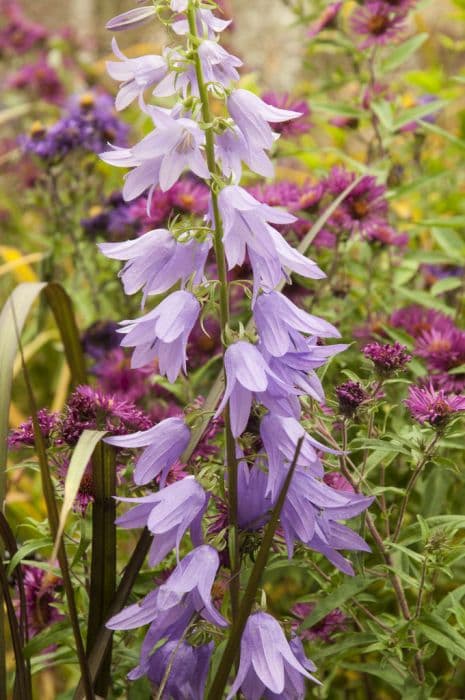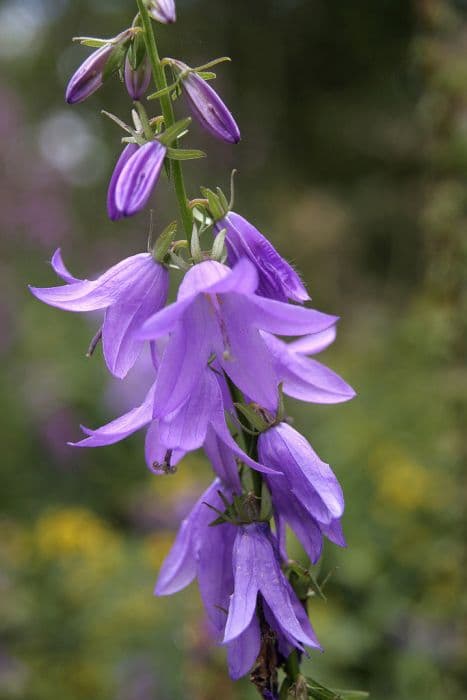Italian Bellflower Campanula isophylla 'Alba'
ABOUT
The Campanula isophylla 'Alba', more commonly known as Star of Bethlehem or Italian Bellflower, is a charming flowering plant that is characterized by its beautiful, star-shaped, white flowers. These blossoms are notable for their delicate, ethereal appearance, and they tend to have a pristine, pure white color that can lend a sense of brightness and serenity to any setting. The flowers are arranged in a generous, loose clusters that cascade elegantly, creating a lovely display of blooms. The foliage of the Star of Bethlehem is equally attractive, with its heart-shaped green leaves that provide a perfect backdrop for the white flowers. The leaves are fresh and lush, creating a dense mound of greenery that further accentuates the white flowers. The overall appearance of the plant is one of grace and simplicity, making it a popular choice for indoor and outdoor decoration alike. The Star of Bethlehem tends to have a trailing habit, which makes it an excellent choice for hanging baskets or as a spiller plant in container gardens. Its trailing stems can drape over the sides of pots or containers, providing a softening effect and adding to the plant's decorative appeal. The contrast between the white flowers and the green leaves is striking, and the plant has a natural elegance that can enhance any garden or home interior. Its flowers and foliage also have a romantic, cottage-garden quality that is often sought after by gardeners looking to create a cozy, inviting atmosphere. The white blooms can also attract various pollinators, adding to the plant's charm and ecological value. Overall, Star of Bethlehem is a visually appealing and versatile plant that can bring beauty and life to a range of settings.
About this plant
 Names
NamesFamily
Campanulaceae.
Synonyms
Star Of Bethlehem, Italian Bellflower, Falling Stars, Trailing Campanula.
Common names
Campanula isophylla 'Alba'.
 Toxicity
ToxicityTo humans
The Campanula isophylla 'Alba', commonly known as Star of Bethlehem, is not considered toxic to humans. There are no well-documented cases of poisoning or serious side effects associated with this plant when touched or ingested by humans.
To pets
The Campanula isophylla 'Alba', or Star of Bethlehem, is not regarded as toxic to pets. This plant is generally safe, and there should be no symptoms of poisoning if pets ingest any part of the plant. However, individual animals might have different sensitivities or allergic reactions to any plant, so it's always best to monitor pets closely and prevent them from ingesting large amounts of any non-food plants.
 Characteristics
CharacteristicsLife cycle
Perennials
Foliage type
Evergreen
Color of leaves
Green
Flower color
White
Height
1 foot (0.3 meters)
Spread
1 foot (0.3 meters)
Plant type
Herb
Hardiness zones
9
Native area
Italy
Benefits
 General Benefits
General Benefits- Decorative appearance: The star-shaped, white flowers of the Italian Bellflower add a delicate and aesthetic charm to gardens, balconies, and indoors.
- Easy to grow: This plant is known for being relatively low-maintenance, making it suitable for novice gardeners.
- Attracts pollinators: The Italian Bellflower can attract beneficial pollinators like bees and butterflies, which are essential for the health of many gardens.
- Versatile placement: It is suitable for both indoor and outdoor environments, provided it gets enough light.
- Fast-growing: It can quickly fill up space in hanging baskets or garden beds, providing a lush green look with abundant blooms.
- Prolonged blooming period: The Italian Bellflower often flowers from late spring until early autumn, providing long-lasting color.
- Good for containers: Its cascading habit makes it an excellent choice for containers and hanging baskets, adding vertical interest.
 Medical Properties
Medical PropertiesThis plant is not used for medical purposes.
 Air-purifying Qualities
Air-purifying QualitiesThis plant is not specifically known for air purifying qualities.
 Other Uses
Other Uses- Adding charm to fairy gardens – Campanula isophylla 'Alba', also known as the Italian Bellflower, with its delicate white flowers, can transform miniature landscapes into enchanting fairy gardens.
- Culinary garnish – The Italian Bellflower's blooms can be used as a decorative and edible garnish in salads or on cakes due to their attractive appearance.
- Photography – The elegant flowers of the Italian Bellflower, with their star shape and pristine color, make them an excellent subject for botanical photography.
- Artistic inspiration – Artists commonly use the Italian Bellflower as a muse for botanical illustrations and other floral art forms thanks to its beautiful, intricate blossoms.
- Wedding decorations – The Italian Bellflower's pure white flowers are quite popular for creating romantic wedding table centerpieces and bridal bouquet accents.
- Ice cubes – Freezing these blossoms into ice cubes can add a touch of sophistication to drinks at special events or during the summer months.
- Educational purposes – The Italian Bellflower is an example used in horticultural courses to educate students on the care and cultivation of ornamental plants.
- Container planting – Being a compact plant, the Italian Bellflower thrives in small containers, making it ideal for balcony gardens and urban spaces.
- Holiday crafts – Dried or fresh, the flowers of the Italian Bellflower can be incorporated into holiday wreaths and ornaments for a natural touch.
- Collector’s item – For enthusiasts of rare or unusual plants, the Campanula isophylla 'Alba' is a prized addition to their plant collection.
Interesting Facts
 Feng Shui
Feng ShuiThe Italian Bellflower is not used in Feng Shui practice.
 Zodiac Sign Compitability
Zodiac Sign CompitabilityThe Italian Bellflower is not used in astrology practice.
 Plant Symbolism
Plant Symbolism- Eternal Love: The bell-shaped flowers of the Campanula are often associated with the idea of everlasting love and affection.
- Gratitude: Giving someone this plant can symbolize your thanks and appreciation for their presence in your life.
- Constancy: Campanula is known for its consistent and long-lasting blooms, which represent faithfulness and the unchanging nature of feelings.
- Humility: Its growth habit, with blooms facing downwards, can signify humility and the act of bowing or yielding.
- Hope: The plant's resilience and ability to grow in difficult conditions are often seen as a symbol of hope and a positive outlook on life.
 Water
WaterThe Italian Bellflower should be watered when the top inch of the soil feels dry to the touch, generally about once a week. It is important to water the plant deeply with room temperature water so that the moisture reaches the roots. Aim to provide the plant with approximately 16 to 24 ounces of water, ensuring thorough saturation. Avoid overwatering by allowing the excess to drain away and never let the plant sit in water as this can lead to root rot. During the winter months, reduce the frequency to accommodate the plant's slower growth rate.
 Light
LightThe Italian Bellflower thrives in bright, indirect light. It's best to place the plant in a spot where it can receive ample light without being exposed to the harsh midday sun, such as a window with eastern or western exposure. Filtered morning sunlight promotes healthy growth and flowering, but direct afternoon sun should be avoided to prevent leaf scorch.
 Temperature
TemperatureThe Italian Bellflower prefers moderate temperatures and does best between 60-75 degrees Fahrenheit. It's important to keep the plant away from drafts and sudden temperature fluctuations. This plant can withstand a minimum temperature of about 45 degrees Fahrenheit, but temperatures below this may cause damage or halt growth.
 Pruning
PruningPrune Italian Bellflower after flowering to maintain its shape and encourage denser growth. Deadheading spent blooms will promote further blooming. Pruning is typically done in late winter or early spring before new growth begins. Remove any dead or damaged stems to improve the plant's overall health and appearance.
 Cleaning
CleaningAs needed
 Soil
SoilThe Star of Bethlehem prefers a well-draining soil mix composed of loamy soil, peat, and sand in equal parts, contributing to a slightly acidic to neutral pH of about 6.0 to 7.5 for optimal growth.
 Repotting
RepottingThe Star of Bethlehem should be repotted every one to two years to provide fresh soil and accommodate root growth.
 Humidity & Misting
Humidity & MistingThe Star of Bethlehem thrives best in moderate to high humidity levels, around 50-60%, to mimic its natural environment.
 Suitable locations
Suitable locationsIndoor
Place Star of Bethlehem in bright, indirect light with well-draining soil.
Outdoor
Plant Star of Bethlehem in partial shade with shelter from harsh elements.
Hardiness zone
7-9 USDA
 Life cycle
Life cycleThe Italian Bellflower 'Alba', or more commonly known as Campanula isophylla 'Alba', begins its life as a seed, which when sown in well-draining soil and under the right temperature and light conditions, germinates to produce small seedlings. As these seedlings grow, they develop a rosette of leaves and a root system. With enough light, moisture, and nutrients, the plant enters its vegetative stage, producing more foliage and elongating stems. The Italian Bellflower 'Alba' reaches maturity when it starts its flowering stage, showcasing white, star-shaped flowers that attract pollinators and can lead to seed production if fertilization occurs. After its blooming period, which may last several weeks to months depending on conditions, the plant may enter a period of dormancy, particularly in cooler climates. If the plant succeeds in dispersing its seeds, the cycle can begin anew, while individual plants can live for several years with proper care.
 Propogation
PropogationPropogation time
Spring to Summer
The most popular method for propagating the Italian Bellflower, Campanula isophylla 'Alba', is through softwood cuttings, ideally done in spring or early summer when the plant's growth is most active. To propagate, select a healthy, non-flowering stem and cut a length of about 3 to 4 inches (approximately 8 to 10 centimeters), ensuring a couple of leaf nodes are included. Strip the leaves from the lower half of the cutting and dip the cut end in a rooting hormone to accelerate root development. Next, place the cutting in a mixture of half perlite and half peat moss or a well-draining potting mix, ensuring the leaf nodes are buried. Water gently and cover the cutting with a plastic bag or place it in a propagator to maintain humidity. Roots typically form within a few weeks, after which the plant can be gradually acclimatized to less humid conditions and eventually potted on as an individual plant.









